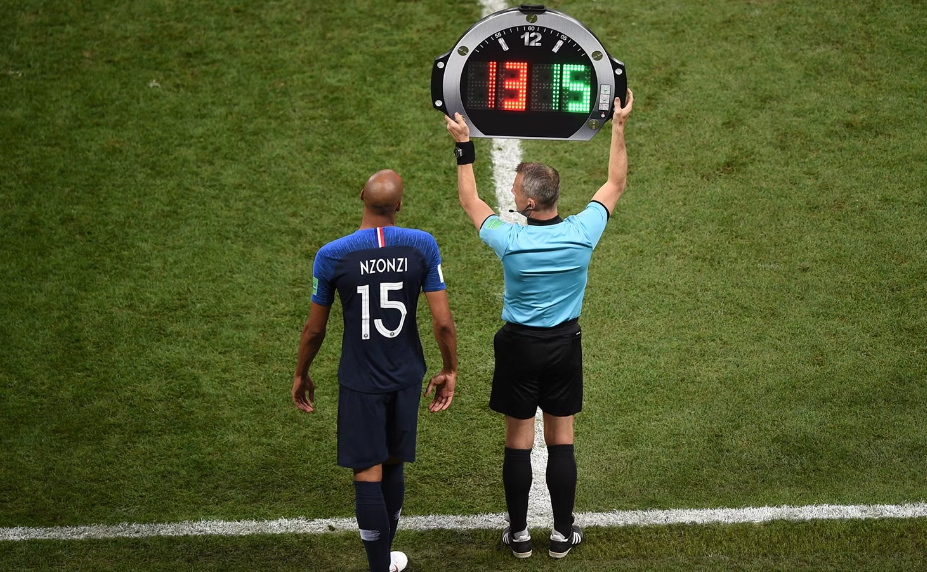How Many People Are on a Soccer Field There are 22 people on a soccer field during a game, 11 players from each team. Soccer is a popular sport played worldwide, known for its fast-paced gameplay and teamwork.
The field is divided into two halves, with each team aiming to score goals by getting the ball into the opponent’s net. The players’ positions and movements are crucial in determining the outcome of the game. The dynamic nature of soccer makes it an exciting and competitive sport to watch and play.
Whether it’s a professional match or a friendly game, the number of players on the field remains consistent, adding to the strategic and skillful nature of the sport.
The Standard Number of Players
When it comes to understanding the dynamics of a soccer field, one crucial aspect is the standard number of players on the field. Let’s delve into the regulations and exceptions that define the player count in a soccer game.

Table of Contents
Regulation Team Size
On a traditional soccer field, a standard team consists of 11 players per side. This regulation team size is commonly observed in professional matches and most amateur leagues. However, variations exist based on age groups and game formats.
Exceptions in Different Formats
In youth soccer, such as U12 or U8 games, the number of players on the field is often reduced to facilitate skill development and ensure all players actively participate. For instance, in U12 games, you might find 9 players per team, while U8 games typically feature 5 players per team.
Roles and Positions
When it comes to soccer, it’s crucial to understand the various roles and positions that players take on the field. From the goalkeeper to the forwards, each position plays a unique role in the game. Let’s delve into the different roles and positions on a soccer field.
Goalkeeper
The goalkeeper is the last line of defense for the team. Their primary role is to prevent the opposing team from scoring by blocking shots on goal. How many players are on the soccer field for U8? In a standard game, there is typically one goalkeeper on the field for each team. However, during special situations, such as a corner kick, the goalkeeper may move forward to support the offense.
Defenders
Defenders are responsible for protecting the goal and stopping the opposing team’s attack. They work closely with the goalkeeper to ensure the opposing team does not get scoring opportunities. Minimum number of soccer players on the field? While the number of defenders can vary depending on the team’s strategy, there are usually four defenders on the field during a game.
Midfielders
Midfielders play a crucial role in connecting the defense and the offense. They are responsible for controlling the flow of the game, distributing the ball, and supporting both the defensive and offensive efforts. How many players are on the soccer field for U8? A standard soccer team typically has three to five midfielders on the field during a game.
Forwards
Forwards, also known as strikers, are tasked with scoring goals. They are the primary offensive players on the team and are constantly looking for opportunities to put the ball in the back of the net. How many players are on the soccer field for U8? A team usually has one to three forwards on the field, depending on the team’s formation and tactics.
Substitutions and Reserves
Substitutions and reserves are an essential part of any soccer team. These players provide an opportunity for coaches to make tactical changes and keep their teams fresh throughout the game. But how many people are on a soccer field during a game? The answer is 22, with 11 players from each team on the field at any given time. In this article, we will explore the rules for substitutions and reserve players in soccer.
Rules on Substitutions
In soccer, a coach can make up to three substitutions per game. These substitutions can be made at any point during the game, and the player being substituted must leave the field before the replacement enters. The substituted player may not re-enter the game, except in the case of a goalkeeper substitution due to injury or illness. If a player is injured during the game, the team can make an additional substitution, but only if they have already used all three of their allotted substitutions.

Reserve Players
Most soccer teams have a squad of players that go beyond the 11 players on the field. These reserve players are usually young, up-and-coming players, or experienced players who are not in the starting lineup. They provide cover in case of injuries or if the coach needs to make tactical changes during the game. Reserve players may be named on the substitutes’ bench and can come on as a replacement during the game, subject to the substitution rules. In some competitions, such as the World Cup, teams may name a squad of 23 players, with the additional players acting as reserves and not being eligible to play in the game unless they replace an injured player on the field.
Officiating and Referees
When it comes to officiating a soccer game, the roles of the referees and assistant referees are crucial in ensuring fair play and upholding the rules of the game. Let’s explore the duties of the referees and the vital role of assistant referees on the soccer field.
How Many People Are on a Soccer Field
The main referee, often referred to as the center referee, holds the primary responsibility for enforcing the laws of the game and maintaining control over the match. Their duties include:
- Enforcing Rules: The referee ensures that all players adhere to the rules of the game, such as fouls, offside, and misconduct.
- Game Management: They are responsible for keeping track of time, ensuring fair play, and managing the flow of the game.
- Decision Making: The referee makes critical decisions, such as awarding free kicks, and penalties, and issuing cautions or ejections when necessary.
- Advantage Assessment: Assessing when to apply the advantage rule, allowing play to continue when a team might benefit from it.
Assistant Referees
Assistant referees play a vital role in supporting the main referee and ensuring the smooth running of the game. Their key duties include:
- Offside Decisions: Assisting the main referee in determining offside infractions during the game.
- Ball Out of Play: They signal when the ball has gone out of play and assist in decision-making related to throw-ins, corner kicks, and goal kicks.
- Foul Recognition: Assistant referees help the main referee in spotting fouls or misconduct that may have been missed.
- Substitution Monitoring: Keeping track of player substitutions and ensuring they are carried out within the rules of the game.
Player Exclusions
When it comes to a soccer field, certain situations may lead to player exclusions, impacting the dynamics of the game. Let’s delve into the consequences of Red Cards and Yellow Cards in a soccer match.
Red Cards
Receiving a Red Card in soccer results in a player being sent off the field, reducing their team’s strength by one player. This disciplinary action is usually due to serious fouls or unsporting behavior.
Yellow Cards
On the other hand, Yellow Cards serve as a warning to players for minor infractions. Accumulating multiple yellow cards can lead to a player receiving a red card and being ejected from the game.
Special Cases
When it comes to a soccer field, various special cases can impact the number of players on the field. Injuries and suspensions are two common occurrences that can affect the composition of a team during a soccer match.
Injuries
Injuries can lead to a team having fewer players on the field than usual. When a player gets injured during a game, they may need to be substituted, resulting in the team playing with one less player. This can impact the team’s strategy and gameplay, as they need to adjust to the new player’s composition.
Suspensions
Suspensions can also affect the number of players on a soccer field. If a player receives a red card or accumulates yellow cards leading to a suspension, the team will have to play with one player less. This can be a disadvantage for the team, as they have to adapt their tactics to compensate for the missing player.
Impact on Team Strategies
When it comes to soccer, the number of players on the field has a significant impact on team strategies. Understanding how many people are on the soccer field can provide insights into the tactical decisions made by teams during a game. This article explores the implications of numerical advantage or disadvantage and the adaptation of tactics based on the player count.
Numerical Advantage or Disadvantage
How many players are on a soccer field for U14? In football, the number of players on the field can create either a numerical advantage or disadvantage for a team. Teams with more players on the field have a higher chance of controlling the game, while teams with fewer players may struggle to maintain possession. Understanding the numerical balance is crucial for teams to capitalize on their strengths and mitigate their weaknesses.
Adapting Tactics
How many people are on the field in football determines how teams adapt their tactics. With fewer players, teams may opt for a defensive approach, focusing on compactness and quick transitions. Conversely, a numerical advantage can lead to a more aggressive playing style, with an emphasis on attacking and exploiting spaces. Coaches and players must be adept at adjusting their tactics based on the player count to maximize their chances of success.
Fair Play and Sportsmanship
Fair play and sportsmanship are two important aspects of soccer. It is not just about winning but also playing the game with integrity and respect for the rules. One of the basic questions that arise in soccer is how many people are on a soccer field. Knowing the answer to this question is important for both players and spectators. In this blog post, we will discuss how many people are on a soccer field and the importance of fair play and sportsmanship in soccer.

Respecting Rules
Respecting rules is an integral part of playing soccer. The rules are put in place to ensure that the game is played fairly and that there is no cheating. Players need to respect these rules and play the game in a manner that is fair to all. This includes following the rules of the game and accepting the decisions made by the referee. Players should also avoid any kind of unsportsmanlike behavior such as fouls, diving, and time-wasting. Fair play is an essential aspect of soccer and is something that players should always strive to uphold.
Ethical Conduct
Ethical conduct is another crucial aspect of soccer. Players need to conduct themselves in a manner that is ethical and respectful. This includes showing respect to opponents and teammates alike, avoiding any kind of taunting or bullying, and playing the game in a manner that is consistent with the spirit of fair play. Additionally, players should also show respect to the officials and refrain from any kind of abusive or disrespectful behavior. Ethical conduct is essential for maintaining the integrity of the game and ensuring that soccer remains a sport that is enjoyable and fair for all.
Conclusion
The number of players on a soccer field can vary depending on the level of play, with professional matches typically having 22 players and amateur games having fewer. Understanding the specific rules and regulations for each level of play is essential for both players and spectators.
Whether you’re a player, coach, or fan, knowing how many people are on the soccer field is crucial for enjoying the game to its fullest.

